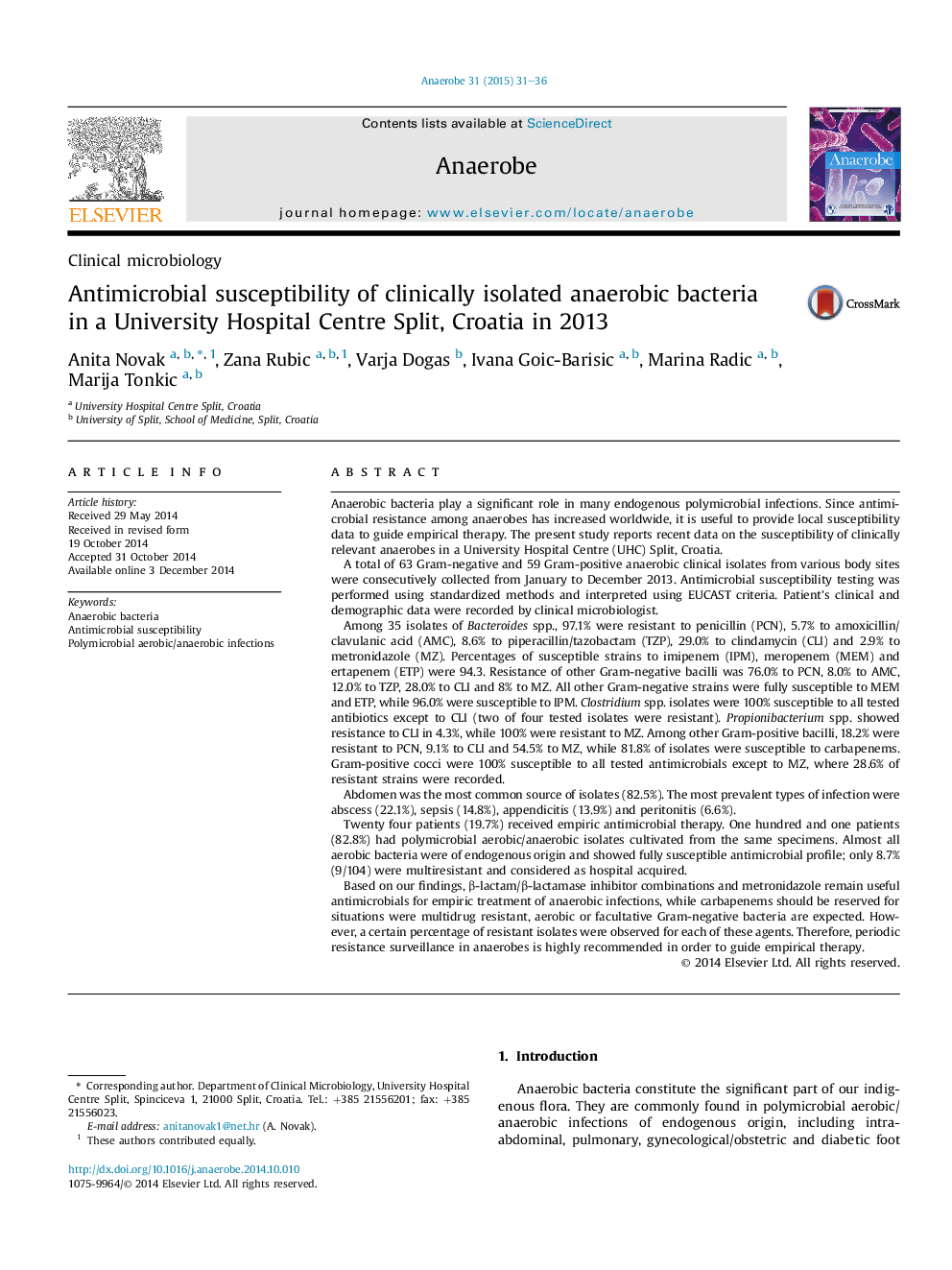| کد مقاله | کد نشریه | سال انتشار | مقاله انگلیسی | نسخه تمام متن |
|---|---|---|---|---|
| 3394976 | 1592832 | 2015 | 6 صفحه PDF | دانلود رایگان |
• 122 anaerobic clinical isolates from various body sites were consecutively collected.
• 101 patients (82.8%) had polymicrobial aerobic/anaerobic isolates.
• Only 8.5% of aerobes were multiresistant.
• β-lactam/β-lactamase inhibitor and metronidazole remain useful for empiric treatment.
• Carbapenems should be reserved for situations were multidrug resistant bacteria are expected.
Anaerobic bacteria play a significant role in many endogenous polymicrobial infections. Since antimicrobial resistance among anaerobes has increased worldwide, it is useful to provide local susceptibility data to guide empirical therapy. The present study reports recent data on the susceptibility of clinically relevant anaerobes in a University Hospital Centre (UHC) Split, Croatia.A total of 63 Gram-negative and 59 Gram-positive anaerobic clinical isolates from various body sites were consecutively collected from January to December 2013. Antimicrobial susceptibility testing was performed using standardized methods and interpreted using EUCAST criteria. Patient's clinical and demographic data were recorded by clinical microbiologist.Among 35 isolates of Bacteroides spp., 97.1% were resistant to penicillin (PCN), 5.7% to amoxicillin/clavulanic acid (AMC), 8.6% to piperacillin/tazobactam (TZP), 29.0% to clindamycin (CLI) and 2.9% to metronidazole (MZ). Percentages of susceptible strains to imipenem (IPM), meropenem (MEM) and ertapenem (ETP) were 94.3. Resistance of other Gram-negative bacilli was 76.0% to PCN, 8.0% to AMC, 12.0% to TZP, 28.0% to CLI and 8% to MZ. All other Gram-negative strains were fully susceptible to MEM and ETP, while 96.0% were susceptible to IPM. Clostridium spp. isolates were 100% susceptible to all tested antibiotics except to CLI (two of four tested isolates were resistant). Propionibacterium spp. showed resistance to CLI in 4.3%, while 100% were resistant to MZ. Among other Gram-positive bacilli, 18.2% were resistant to PCN, 9.1% to CLI and 54.5% to MZ, while 81.8% of isolates were susceptible to carbapenems. Gram-positive cocci were 100% susceptible to all tested antimicrobials except to MZ, where 28.6% of resistant strains were recorded.Abdomen was the most common source of isolates (82.5%). The most prevalent types of infection were abscess (22.1%), sepsis (14.8%), appendicitis (13.9%) and peritonitis (6.6%).Twenty four patients (19.7%) received empiric antimicrobial therapy. One hundred and one patients (82.8%) had polymicrobial aerobic/anaerobic isolates cultivated from the same specimens. Almost all aerobic bacteria were of endogenous origin and showed fully susceptible antimicrobial profile; only 8.7% (9/104) were multiresistant and considered as hospital acquired.Based on our findings, β-lactam/β-lactamase inhibitor combinations and metronidazole remain useful antimicrobials for empiric treatment of anaerobic infections, while carbapenems should be reserved for situations were multidrug resistant, aerobic or facultative Gram-negative bacteria are expected. However, a certain percentage of resistant isolates were observed for each of these agents. Therefore, periodic resistance surveillance in anaerobes is highly recommended in order to guide empirical therapy.
Journal: Anaerobe - Volume 31, February 2015, Pages 31–36
